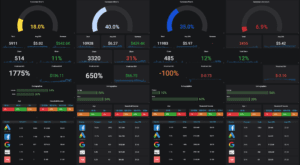We are going to see more change in the next 10 years than we have in the past 30 and this change will be driven by AI-enabled technologies. We'll see industries collapse and new industries created. We'll see jobs that existed for hundreds of years suddenly disappear. We'll become accustomed to working with our robot assistants and we'll see massive employment disruption as ‘information jobs' become obsolete.
We can deal with this change in two ways: adapt or fold.
AI is still in the very early stages of adoption at most companies or a ‘wish list' item for others.
For even more companies it's a source of confusion – what is AI, what does it do, how can I leverage it for my business, and how can I prepare?
What is AI?
Modern AI really is one thing: pattern matching based on historical data. What can your past data tell you about the present and the future?
At its heart, AI is really math that predicts a probability. What's the probability of churn, what's the probability of conversion, what's the probability that a customer will respond to a specific offer?
With this type of information, you can leverage an AI algorithm to segment customers, to predict behavior, to detect fraud, to personalize offers, and to engage and interact with customers.
What Does AI Do?
AI is very much a hard-coded science right now. The machines are not autonomous yet. There are Auto-ML solutions available but these solutions just automate the task of testing different algorithms and identifying what data is predictive.
An AI algorithm very simply takes data in, and predicts an answer.
Different types of AI include:
- Machine Learning: math formulas used for prediction
- Natural Language Processing (NLP): identifying insights from text-based data
- Chatbots (also an NLP solution): Interact with customers and provide answers
- Deep Learning: deeper pattern matching to make predictions
How Can I Leverage AI?
Before leveraging AI, the precursor is that you need data. One of my favorite quotes is “The most powerful AI Algorithm in the world: ÷ ”
There's a lot of truth to this. If you aren't doing basic metrics and KPIs to track the health of your business, that's a first step in understanding your data.
From here, the next step is to become data-driven, meaning basing decisions on data, not opinions.
What AI enables you to do is really to understand and respond to your customer on a personalized level. Who are they and what do they care about? By creating customer segments and micro-segments and understanding their behavior patterns, you can predict their behavior and personalize their experience. The goal is to transform from:
HIPPO: Highest paid person's opinion.
to
Data-Driven: We use data to make informed decisions.
to
AI-driven: We use data to predict behavior and act on those insights.
Preparing for AI
Many companies won't make the leap. They have old ways of thinking that inhibit them from adapting. Instead of thinking of AI as a new tool to help them be more efficient and help them do more and service their customers better, they think of it as a fad that will go away because ‘that always happens.'
Last year I did a lunch and learn presentation and got significant flack from the owner of a call center. He said “I've been doing this a long time and people want to talk to people. AI will never replace call centers.”
After removing my jaw from the floor (this is predicted to be one of the FIRST industries that is fully automated), I pointed out that customers don't pay for call centers, companies do and if there's a solution that costs significantly less than a person and works as well or better, then companies would certainly fire their humans in lieu of a 24×7 workforce that works for pennies per hour and is never sick.
So, if you don't want to be stuck in last-century thinking, here are some questions to. ask yourself:
- What is your current relationship with data? Do you make decisions from your gut or from your analytics system? (I find it it amazing the number of times when I've asked ‘can I run a query to find out how many customers might be affected' after an executive has made a decision without understanding the impacts.)
- How am I leveraging data to monitor the health of my business? Do I regularly look at the standard metrics for my industry or only when an investor needs an update?
- How do you care for and feed your data now? (Yes – data requires care and feeding.) Do you have processes that aggregate, normalize, and cleanse your data to create insights or is it ‘another thing we don't have time for'?
- What's a quick win that I can achieve? Find better customers? Improve retention? Reduce ad spend? Automate service tasks? Personalize offers? Find something small that adds a lot of value to your business and customer experience. There are many use cases that are easy to implement.
- How will your employees respond to their AI assistants? Will they revolt and complain or will they be grateful for the mind-numbing work that is off their plate?
- What is my company culture for risk? What might happen if our predictions are wrong? Are our customers forgiving? Is our leadership team forgiving? Innovative technologies mean ‘learnings' (aka mistakes) happen and head-rolling cultures won't get the benefits of experimentation.
- What can I learn from my customers? How do they behave, what are their common attributes, what engages them and what disengages them?
- Are my competitors hiring data scientists? Do I need to invest just to keep up? (This is probably the worst reason to invest in AI but may be a driver for change in some organizations.)
Fuel or Overhead
Overall, transforming for the next decade means that things will change and in some cases, that change may start with you. The final question to ask yourself is your own personal philosophy with data.
Is your data fuel that creates competitive advantage for your company, or does it sit on a server (or multiple servers and systems) and no one ever looks at it.
Companies that adopt, adapt, and learn will have a significant competitive advantage in the next decade.








